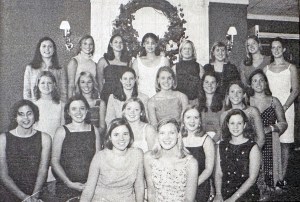The Town Crier: City limit limits (part 2)
Published 11:00 am Sunday, August 6, 2023

- The Town Crier
Last week we were checking out the Unified Zoning Ordinance agreed upon between Whitfield County and the cities of Dalton and Varnell. Those rebels up in Cohutta and Tunnel Hill have yet to join the club, although I’m pretty sure they aren’t letting their folks build “widow walks” on top of their houses without guardrails.
At the beginning of the document there are definitions for words used in the following ordinances and we were getting a good understanding of what was what, and also keeping an eye out for loopholes we could exploit and make a buck off of. Well, I was anyway.
Trending
Definitions are in alphabetical order and we were in the C’s and had just defined the difference between a convenience center and a convenience store. The latter is where you buy stuff and the former is where you throw it away.
Next up is one for you “dead enders” living in a cul-de-sac. Your cul-de-sac to meet standards has to be at least 80 feet in diameter. How’s that for an obscure bit of information. I wonder what the 80 feet is based upon. My guess is the turning radius of a school bus. Or perhaps the diameter of a circle needed to turn a big pickup truck pulling a bass boat around.
‘But wait, there’s more!’
Moving into the D’s we get to “density,” which has to do with the number of dwellings on a given acre of land. I’m a little confused by the definition here because it says “Density is the number of dwelling units per acre of land.” That’s simple enough, but then it goes on to define “gross density” and “net density.”
Gross density refers to ‘the number of units per acre of the total land to be developed.” “Net density refers to the number of units per acre of land devoted to residential use.” Hmmm. Not sure I get the difference. So let me look at what a “dwelling” is and then a “dwelling unit,” since that’s two different things in here.
Dwelling (which I bet is what you think you live in … ‘But wait, there’s more!’ as they say in the old TV commercials) is defined as a building designed or used for residential purposes, and that includes a house, duplex, manufactured homes, sorority house, dormitory or a boarding house.
Trending
Do we still have boarding houses around here? I barely remember The Crow House boarding house downtown when I was a kid across from where Posten Motors used to be.
So a dwelling is any building where people live full time, therefore not a hotel or motel.
A dwelling unit is one or more rooms that is set aside from others in a dwelling to live in with such things as a kitchen, bathroom, etc. Got it! If you live in one side of a duplex, let’s say, you’re in a dwelling unit, while the whole building constitutes a dwelling. If there are four duplexes on an acre then there are four dwellings but eight dwelling units per acre. I may have found another loophole, though. When I’m in the “doghouse” with my wife, does that constitute a separate dwelling unit? It sure isn’t a hotel!
Dwellings constitute such an important part of what the community codes are there for that dwellings is broken down into a variety of detailed descriptions. These include “single-family dwelling,” “multi-family dwelling,” “single-family dwelling attached,” “two-family dwelling (duplex),” “urban dwelling” and “zero lot line dwelling.” Choices, choices, choices.
I guess any more than a two-family dwelling duplex goes to multi-family dwelling and circumvents the need to call something a tri-plex, quad-plex or any other higher-plexes. That way you can say “I live in an apartment condo” rather than having to explain to someone what a heptadeca-plex is, which is a 17-family dwelling … but you already knew that, I bet.
With a three or more family dwelling you’re getting into what’s defined as a “townhouse” or “row-house,” clearly an effort by the writers of the ordinance to avoid having to learn a lot of Greek numerical terms. Heaven forbid one person says heptadeca-plex and another says septadeca-plex and they argue over it, when the two words mean the same thing, a 17-family-dwelling.
An “urban loft” has its own definition and while reading it I think I’ve found another loophole, or perhaps it’s just a bit of a misnomer. When you say urban I think of something in the city. But looking through the whole definition of urban loft all it really says is that it’s a dwelling unit above a commercial business on the ground floor. It could be a standalone business out in the middle of the boondocks with a living space above it, regardless of there being other businesses next to it.
By definition it doesn’t even have to be on a paved road. You could go live above a hay store out in the county and go to New York City and mention to the passersby that you too are by definition an urban loft dweller just like them. They may question the mud on your boots, the overalls with the sides unbuttoned to slide your hands into while chatting, and the hay-straw you’re chewing on, but let them look up our unified code and figure it out for themselves. Meanwhile, keep your wallet in your front pocket, you’re in New York.
A fence of great creativity
For your dwelling you may need or want a fence. It can be to keep the cows out or the nosy neighbors from peeking. What I like about the definition of a fence is that it is an artificially constructed barrier of “any materials or combination of materials.” That leaves the door open for a fence of great creativity.
For lottery winners, the options are almost endless. Think of a stacked stone fence. Now think of a brick and wooden fence. You won the lottery, let’s go with a copper and brass fence to let the neighbors know who won big. How about a one-way mirror fence? You can watch the neighbors, but they can only watch themselves. With the non-specific definition of fencing materials, let your imagination be your guide! Surely the county inspector will applaud your creativity when he checks out your newly installed barb-wire and silk fence that’s functional and decorative all at once.
For “garage” there are definitions for “parking garage,” “private garage” and “general service garage.” Parking garage is the general term, private garage is specifically for people using the building to park and general service is where you take your car to be worked on.
Garage also shows up for the definition of “garage, yard or carport sales.” While we’re finding a place to stow our car, “off-street parking space” is the definition for the amount of space needed to park a single car. But there’s no set measurement assigned to that definition, as you may have realized if you’ve looked for a parking space at some of the shopping centers or grocery stores around here. There’s a big difference between a giant pickup truck or SUV and one of those little European numbers like a Fiat or Mini-Cooper and what constitutes space for a single vehicle.
‘Susceptible to being inundated’
The property itself also has some things to be aware of. One is if you are on a “flood plain” or not. If you asked me what a flood plain is I would say that flat area along a creek or river where the water comes up to when the water floods. The zoning ordinance writers define it as “any land area susceptible to being inundated by/from any source.” With a definition like that, that means my neighbor down the hill lies in a potential flood plain from my watering the garden and forgetting to turn off the hose before going to bed. I’ve done it before. I’m not saying he can start a catfish pond down there, but “inundated” works.
And there’s a definition for a “flag lot.” I didn’t know what that was until I read the definition and realized it’s what I call a mailbox lot. It’s basically a lot of land that you can get to only by a driveway, with the lot as a whole placed behind another lot with more frontage. In other words, you get to the “flag” part of the land by driving up the “flagpole” to get there. There’s also a “corner lot” and a “double corner lot.” The corner lot is what it sounds like, a lot on the corner of an intersection, a double corner lot is a lot with three sides being roads frontage. Sounds like you’re going to have trouble getting out of the driveway during rush hour.
Next week we’ll finish off the definitions of the Unified Zoning Ordinance, with it being the hope of the Town Crier that you’ll find it educational, whether you’re building or buying property or just want to sound extra knowledgeable around your friends when you spot an empty parking space and yell out “Hey look, an off-street parking space unoccupied and available!”





